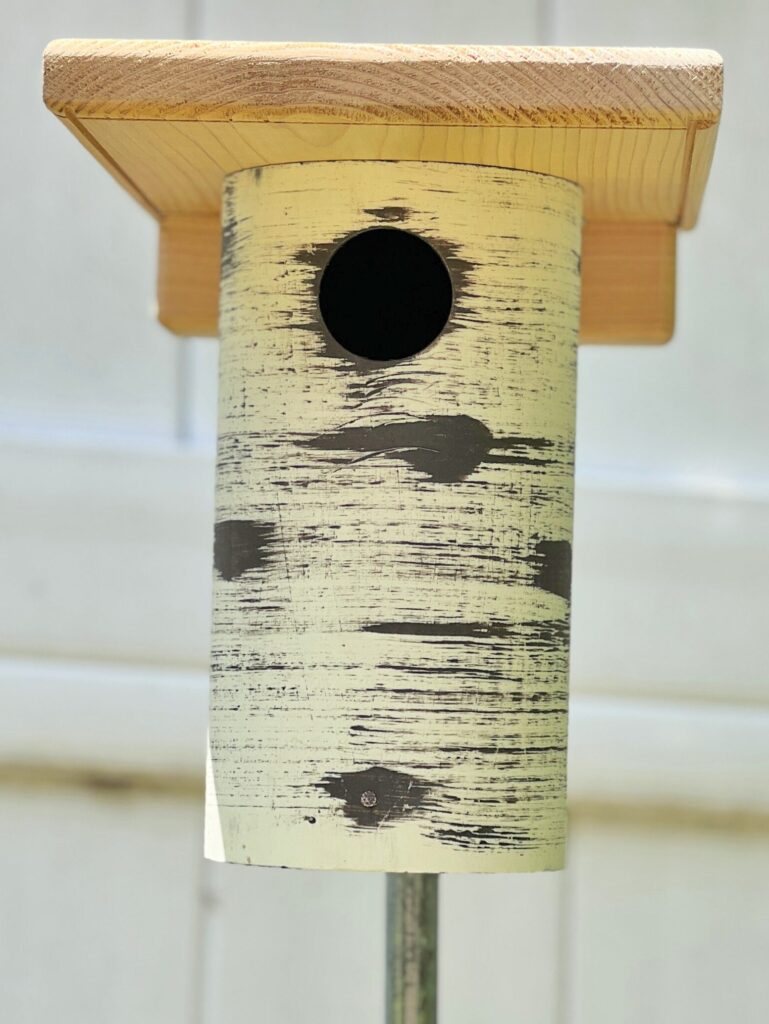by Steve Gilbertson (reprinted from the May 1998 BBRP Newsletter “Bluebird News”)
 Fairly often I hear or read about individuals that do well with my design nest box and sometimes I hear they do not so well. While I feel that a majority of the feedback is accurate, I’ve discovered that some people’s idea of a Gilbertson box is simply a birdhouse made from PVC plastic.
Fairly often I hear or read about individuals that do well with my design nest box and sometimes I hear they do not so well. While I feel that a majority of the feedback is accurate, I’ve discovered that some people’s idea of a Gilbertson box is simply a birdhouse made from PVC plastic.
Samples of “modified” Gilbertson boxes contained everything from major flaws in quality to some with serious flaws in their design. Problems included:
- very thin; untreated roofs which would readily split, allowing rainwater to go into the nest cavity · roofs barely larger than the body itself, providing no shade or weather protection
- floors not recessed into the body, allowing water intrusion by capillary action
- a depth of less than 4″ from the bottom of the hole to the top of the floor
- unpainted – while this may not qualify as a flaw, in my opinion white PVC boxes must be painted. I use brown oil-based solid-color exterior stain. Spray paint is fine. Avoid latex because it peels. The inside is painted to lessen light intrusion through the sidewall and to allow the female to contrast less than with white. The outside is mottled to look like tree bark.
The Gilbertson nest box system is unique and evolved in 1989 out of my desire to isolate and correct what I felt were shortcomings in many nest box designs and mountings which could result in failed nests. Ants, snakes, mice, cats, squirrels and raccoons were problems connected – literally – to the ground. House sparrow problems could be related directly to box design. Human nature had to be taken into consideration as it affects why and how many nest boxes are put up. To me, this meant creating a lightweight box coupled with fast, easy and economical installation. Tamper protection and quality monitoring was yet another challenge.
To act on these concerns was a tall order to be sure, but by 1991 a nest box and mount evolved that to this day has changed very little. After a brief and foolish trial with treated cardboard carpet tubes as nest box bodies fastened to a wooden roof. I settled on 4’ thin wall PVC (polyvinylchloride) pipe, which was lightweight, strong and easily cut to length. This could be stained or painted brown on the inside and mottled brown on the outside.
Tamper-protection and quality monitoring is achieved by creating a two-piece box connected by outward-projecting pins. Squeezing the body at the roof-line elongates its distance, allowing detachment by compressing the body. Unwanted human visitors are stymied, as they look for a protruding screw or nail to open it. When the trail monitor detaches the body properly, he or she can lower the box down and have a full view of the neat and contents. Children don’t need to be lifted up to get a quick, elusive glimpse. Field trip participants can share equally in the delightful view and exposure to bluebirding.
Sparrow resistance was an issue that I honestly felt might not be resolved without creating bluebird resistance at the same time. Luckily, sparrows prefer a greater volume of nest material, and usually create a tunnel-like route to the inner cup. It stood to reason that the thin-walled, 4″ diameter might be too confining for them, and therefore sparrow-resistant. Experimenting with 4″ PVC boxes of various depths, I discovered that house sparrows lost interest when the box was only 4&1/2″ deep. Bluebirds were not interested in a PVC box shallower than 4″.
A major problem still existed in protecting the nest box from ground creatures. I searched for the thinnest, smoothest, strongest and cheapest mounting system. That came to mean a 5′ section of thin-wall conduit rubbed with coarse steel wool and then waxed. The conduit can then be screwed or wired to an existing wood or steel post, or much better, used as a free-standing post: This requires a 4 or 5 foot section of 1/2″ rebar (reinforcing iron rebar used in concrete structures) driven partially into the ground. The l/2″ conduit is slid over the rebar. (The rebar is actually l/ 2″ exterior size; the conduit is 1/2″ interior size, so the conduit slides easily over the rebar). A conduit clamp with a slightly longer bolt in the lower hole to firmly contact the rebar, secures the conduit and rebar together, and keeps the conduit from twisting on the rebar.
To properly build a conduit-mounted Gilbertson nest box is neither complicated nor expensive. Its sparrow resistance is unequalled while it is still highly successful with bluebirds. It is easily installed, moved around or removed and affords superior protection from ground-based predators. I’ve raised nearly 1500 bluebirds in 7 years, using only this system. I think it is the best.
- by Steve Gilbertson, 35900 Dove Street, Aitkin, MN
More Information:
- Nestbox designs, pros & cons
- Nestbox specifications
- Gilbertson box, safety of PVC
- Nestbox plans
From ancient times, man has been aware of birds and attempts have often been made to encourage them to nest where they could be enjoyed or where they would be helpful in controlling insects.
– Dr. Larry Zeleny
